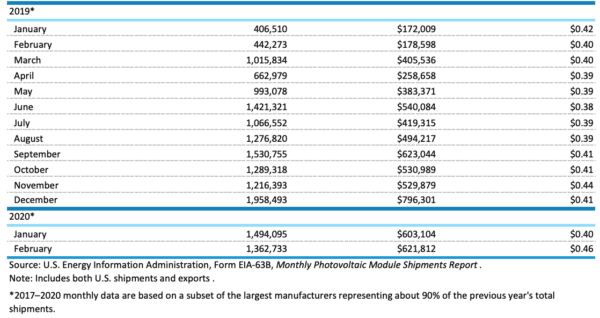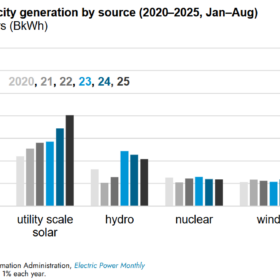In the latest edition of the the U.S. Department of Energy’s Energy Information Administration’s (EIA) Monthly Solar Photovoltaic Module Shipments Report, the administration outlines that 1.36 GW of PV modules were shipped in February. This figure is down from the 1.49 GW shipped in January and 1.96 GW shipped in December.
While down since December, the 1.36 GW of modules shipped represents a 308% increase in the 442 MW shipped in February 2019.

Moreover, the early 2020 shipment figures are in-line with the shipment spike that began in the second half of 2019, as companies looked to safe harbor project components prior to the ITC step-down that began in 2020. Solar projects were able to quality for the full 30% ITC if they started physical work by the end of 2019, while developers were able to lock in the 30% ITC through a safe harbor provision, by paying for 5% or more of the cost of a project. Considering that modules represent more than 5% of total project costs, securing modules was a safe way to ensure the full ITC.
Shipments down, but still strong
Since June 2019, no month has featured less than 1 GW shipped, a streak nearly double the length of the previous record from August-November 2017. It’s unclear how much of the shipments have been imports as compared to exports over that time, as the EIA has withheld that data every month since December 2018.
California, predictably, was home to the most shipments in February, with 420 MW. Rounding out the top-five came Texas with 141 MW, Tennessee as a surprise entry with 85 MW, New Jersey with 55 MW and Florida with 44 MW. Tennessee had 58 MW shipped in January, a noticeable amount considering that the two month combined shipment capacity represents more than 33% of the state’s entire installed capacity thus far.
The Tennessee figures could have something to do with the 484 MW of new solar capacity that the Tennessee Valley Authority has contracted since December.
More stockpiling on the horizon?
While month-by-month shipments are down, the average price-per-watt rose drastically in February, up to $0.46 from $0.40 in January. $o.46 is the highest per-watt price in a single month since June 2018 and the largest single month jump in price since May to June of 2018.
What this data doesn’t show yet is the extent to which the Covid-19 pandemic has affected module shipments. Some installers shared with pv magazine that they were stockpiling modules and other equipment in preparation for any supply chain disruptions. The February price spike could be reflecting a supply concern-related rise in demand.
This content is protected by copyright and may not be reused. If you want to cooperate with us and would like to reuse some of our content, please contact: editors@pv-magazine.com.









“While month-by-month shipments are down, the average price per kW rose drastically in February, up to $0.46 from $0.40 in January. $o.46 is the highest per kW price in a single month since June 2018 and the largest single month jump in price since May to June of 2018.”
Historical reference: In 2005 the latest/greatest solar PV technology at the time was top end solar PV was at 200 watts per panel and the cost was $5.50/watt retail. Now, typical solar PV panels are in the 330 watts per panel neighborhood and cost from around $0.75 to $1.25/watt, even with tariffs. Before the Covid-19 interference in World wide commerce, there were quotes coming out of China for bifacial solar PV in manufacturing runs of $0.28/watt. Utility scale at $0.46 kW us still very cheap are you sure it is kW or is it Watt? The EIA has been famous in the past for numbers and “predictions” that are way off.